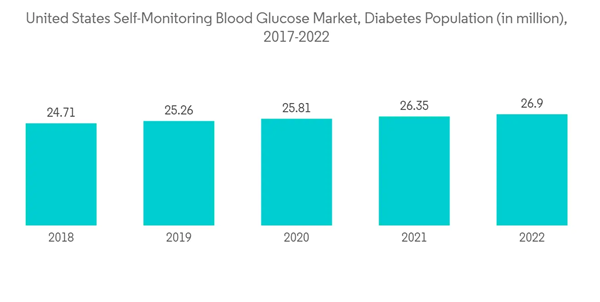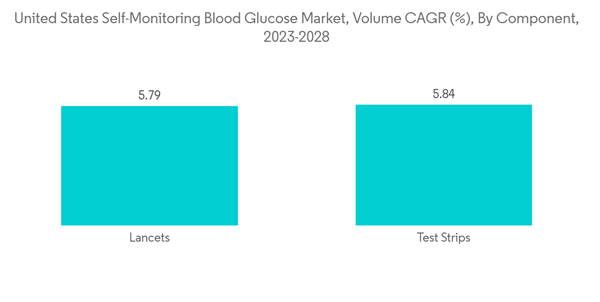According to the CDC, routine diabetes management was important to reduce the risk of bad health outcomes and severe COVID-19 in diabetes patients. However, the pandemic caused disruptions in diabetes management, a worsening of glycemic control, and more cases of severe diabetic ketoacidosis. Between April and August 2020, about 60% of people who were just diagnosed with type 1 diabetes had diabetic ketoacidosis as their first sign or symptom.This is about twice as many as in previous years, which suggests that people with diabetes are taking longer to seek care and get diagnosed. During the COVID-19 pandemic, glycemic control got better when people used telemedicine or checked their own blood sugar.
Blood glucose monitoring increases patients' awareness of glucose values, which supports healthy lifestyle choices. Blood Glucose Monitoring values help in providing feedback and guidance on how to make health behavior changes when needed. Continued elevation in blood glucose levels in diabetes patients can contribute to progressive complications such as renal, nerve, and ocular damage. Appropriate and timely monitoring of blood glucose allows the successful management of out-of-range blood glucose levels, minimizing diabetic-related health complications.
According to the National Center for Health Statistics, approximately 32.8% of adults aged 18 and over in the United States will be obese in 2021. When a person is overweight, their fat cells release chemicals that cause inflammation. These chemicals may make the body less sensitive to the insulin it makes by messing up the way insulin-responsive cells work. So, these people need insulin shots from the outside and have to use a device like a glucometer to check their blood sugar.
Innovative technologies, such as digital health apps that show and summarize each person's blood glucose readings and add other relevant data like insulin doses, meals or snacks, and physical activity, can help people better manage their own diabetes while reducing the burden of the disease and improving care overall. Integration of blood glucose monitoring with insulin calculators, automated insulin titration software, and remote coaching are all new developments that give patients with poorly controlled diabetes the extra help they need to improve critical outcomes, which will improve the market's prospects in the years to come.
US Self-Monitoring Blood Glucose Market Trends
Rising Diabetes Prevalence in the United States
According to the CDC's National Diabetes Statistics Report 2022, more than 130 million adults in the United States have diabetes or prediabetes. People of color, people who live in rural areas, and people with less education, lower incomes, and less health literacy are more likely to have type 2 diabetes, and it is more dangerous for them.The ADA, the Endocrine Society, the American College of Physicians, the American Academy of Pediatrics, the Society of General Internal Medicine, and the National Academy of Medicine all put out statements and calls to action about SDOH at the individual, organizational, and policy levels.In 2021, the ADA also published a scientific review about the links between SDOH and diabetes risk and outcomes. The review focused on socioeconomic status, health literacy, the food environment, food insecurity, and the neighborhood and physical environments, among other things.
Self-monitoring is a commitment that many diabetic patients follow to manage their condition. The blood glucose levels help the patients and doctors modify their diet, lifestyle, insulin therapy, and medications to help their blood sugar return to normal. With newer innovations in medical technology, glucometers these days have highly sensitive strips and sensors that can detect every component of blood accurately, close to lab results.
In the United States, there are several innovations in diabetes management platforms by startups, like Glooko, OneDrop, Verily, Vacate, Insulet, Noom, Bigfoot Biomedical, Virta Health, Diabeloop, and Orgenesis, which have launched in the market. People are learning more about advanced diabetes devices, which is making blood glucose monitoring devices more flexible.To get a large share of the market, the top manufacturers are putting a lot of effort into developing new technologies and making more advanced products.
In May 2021, the World Health Assembly agreed on a resolution to make it easier to stop diabetes and keep it under control.It makes suggestions for things that can be done, like making insulin easier to get and making sure that insulin and other medicines and health products used to treat diabetes have the same rules.In May 2022, the World Health Assembly agreed on five goals for the treatment and coverage of diabetes around the world by 2030.
Therefore, the studied market is anticipated to witness growth over the analysis period due to rising prevalence and the aforementioned factors.
The Test Strips Segment held the highest market share in the current year
The Test Strips Segment recorded a market share of about 80% in the current year.Blood glucose test strips are small, disposable strips that are a key component of blood glucose testing. When blood is placed on the test strip, it reacts with a chemical called glucose oxidase, producing gluconic acid from the glucose in the blood. At the other end of the test strip, the meter transfers a current to the test strip. The test strip has electric terminals, which allow the meter to measure the current between the terminals. The current between the terminals changes depending on the level of gluconic acid that has been produced. The blood glucose meter then uses an algorithm to work out the blood glucose level based on the difference in current.
The growth in market share of test strips is expected to be higher than that of glucose meters because of the difference in use-case frequency. The glucometer is a one-time purchase; however, test strips, on the other hand, are a continuous investment as a test strip needs to be disposed of after one use, causing a recurrent cost impact. An average glucose meter lasts anywhere between six months and three years, presenting a one-time cost during the same time frame.
The federal health insurance program Medicare (Part B and Part D) pays for diabetes supplies to help doctors, providers, suppliers, and other healthcare professionals who give diabetic supplies to people with Medicare. Medicare Part B covers diabetic supplies such as blood glucose self-testing equipment and supplies, therapeutic shoes and inserts, insulin pumps, and the insulin used in the pumps. Blood glucose self-testing equipment and supplies are covered for all people with Medicare Part B who have diabetes. This includes those who use insulin and those who do not use insulin. Such reimbursement policies and the aforementioned factors are expected to drive the market over the forecast period.
US Self-Monitoring Blood Glucose Industry Overview
The United States self-monitoring blood glucose market is moderately fragmented, with a few significant and other generic players. Manufacturers like i-Sens, Abbott, LifeScan, and Ascensia occupy a major share.Additional Benefits:
- The market estimate (ME) sheet in Excel format
- 3 months of analyst support
This product will be delivered within 2 business days.
Table of Contents
Companies Mentioned (Partial List)
A selection of companies mentioned in this report includes, but is not limited to:
- Abbott Diabetes Care
- Roche Holding AG
- LifeScan
- Trividia Health
- Ascensia Diabetes Care
- Acon Laboratories Inc.
- Agamatrix Inc.
- Bionime Corporation
- Rossmax International Ltd.
- Arkray Inc.
Methodology

LOADING...










